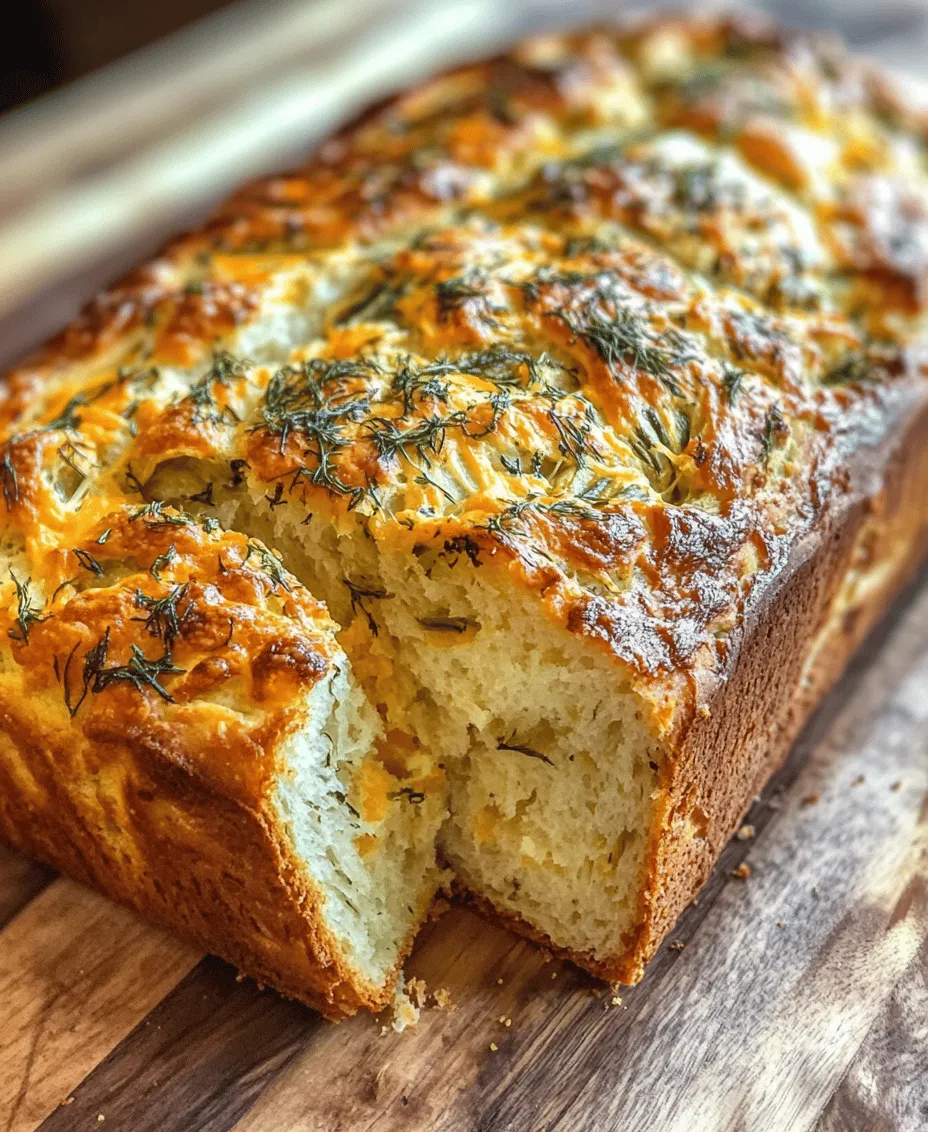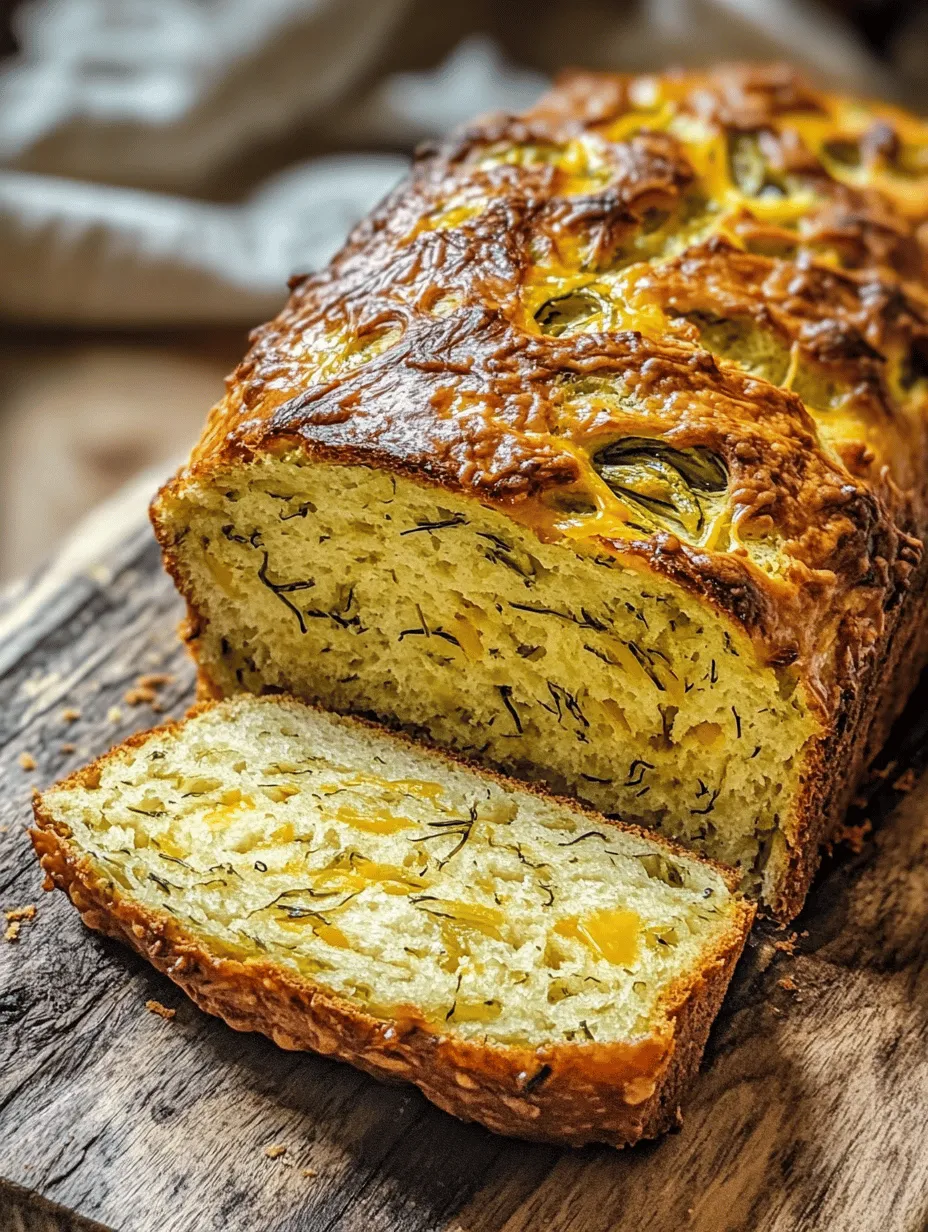In recent years, the culinary world has witnessed an exciting trend: unconventional bread recipes that challenge traditional norms and inspire home bakers to explore new flavor profiles. Among these innovative creations, Dill Pickle Bread stands out as a delightful blend of savory and tangy flavors, captivating the taste buds of adventurous eaters and pickle enthusiasts alike. This unique bread not only celebrates the beloved dill pickle but also serves as a testament to the creativity that can thrive in the kitchen.
Dill Pickle Bread offers a remarkable twist on classic bread recipes, allowing the distinct taste of dill pickles to take center stage. This bread is an ideal treat for gatherings, picnics, or simply as a flavorful accompaniment to your meals. Whether enjoyed fresh out of the oven or toasted with butter, its unique flavor combination is sure to leave a lasting impression.
The Allure of Dill Pickle Bread
Historically, pickles have held a cherished place in culinary traditions across cultures. From the tangy gherkins of Germany to the spicy pickles of India, these preserved cucumbers have delighted palates for centuries. The rising popularity of pickles in contemporary cuisine has led to a renewed interest in their versatility, inspiring chefs and home cooks to incorporate them into unexpected dishes, such as Dill Pickle Bread.
As food trends continue to evolve, fusion and comfort food remain at the forefront of culinary exploration. Dill Pickle Bread perfectly embodies this trend, combining the nostalgia of homemade bread with the tangy punch of pickles. The flavor profile is an exquisite balance of sweetness from sugar, tanginess from the pickles, and savory elements from spices, creating a loaf that is both comforting and exciting.
This bread’s appeal goes beyond its taste; it represents a creative outlet for those looking to experiment with flavors. For pickle lovers, this recipe is an invitation to indulge in their favorite ingredient in a new and innovative way. The potential for customization—such as adding cheese or herbs—further enhances its allure, making it a versatile option for any occasion.
Ingredients Breakdown
To create the perfect Dill Pickle Bread, you’ll need a selection of ingredients that work together harmoniously. Each ingredient plays a crucial role in achieving the desired flavor, texture, and structure of the bread.
1. All-Purpose Flour: The foundation of the bread, all-purpose flour provides the necessary structure and stability. It forms the gluten network that gives the bread its chewy texture.
2. Dill Pickles: As the star ingredient, dill pickles contribute a unique tangy flavor and moisture to the bread. Chopped finely, they add texture and bursts of flavor with each bite.
3. Baking Soda and Baking Powder: These leavening agents are essential for achieving the right texture in your bread. Baking soda reacts with the acidity of the pickles, while baking powder provides additional lift, ensuring a light and airy loaf.
4. Salt and Spices (Garlic Powder, Onion Powder): Salt enhances the overall flavor of the bread, while garlic and onion powder add aromatic depth. These spices complement the dill pickle flavor, creating a well-rounded bread.
5. Sugar: A small amount of sugar balances the tartness of the pickles, enhancing the flavor without making the bread overly sweet.
6. Vegetable Oil: Adding moisture and richness, vegetable oil helps keep the bread tender. It also contributes to the overall flavor profile, ensuring a delicious end product.
7. Eggs: Eggs act as a binding agent, helping to hold the ingredients together and providing structure to the bread. They also add richness and contribute to the bread’s color.
8. Dill Weed and Cheddar Cheese (Optional): For those who want to elevate their Dill Pickle Bread, incorporating dill weed adds an extra layer of dill flavor, while cheddar cheese introduces a creamy, savory richness.
Step-by-Step Instructions for Perfect Dill Pickle Bread
Creating Dill Pickle Bread is a straightforward process that begins with preparation and attention to detail. Follow these steps to ensure your bread turns out perfectly every time.
Step 1: Preheat the Oven and Prepare the Loaf Pan
Start by preheating your oven to 350°F (175°C). This temperature is crucial for achieving the right texture in your bread, allowing it to rise and bake evenly. While the oven is heating, prepare your loaf pan by greasing it lightly with cooking spray or oil. This step prevents the bread from sticking and ensures easy removal once baked.
Step 2: Mixing Dry Ingredients
In a large mixing bowl, combine the all-purpose flour, baking soda, baking powder, salt, garlic powder, onion powder, and sugar. Whisk the dry ingredients together thoroughly to ensure an even distribution of the leavening agents and spices. This step is vital for consistent baking, as clumps of baking soda or powder can lead to uneven rising and texture in your bread.
Once the dry ingredients are well combined, you are ready to move on to the next steps, which will bring your Dill Pickle Bread to life. As you continue with the recipe, the enticing aroma of dill pickles will transform your kitchen into a haven for comfort food lovers, setting the stage for a truly delightful culinary experience.
As you embark on this baking adventure, remember that Dill Pickle Bread is not just a recipe; it is an opportunity to explore the intersections of flavor and creativity in your cooking. Whether you’re making it for a special occasion or simply seeking a new loaf to enjoy at home, this unique bread is sure to impress and satisfy.

Preparing the Wet Ingredients
The heart of any great bread lies in its wet ingredients. For Dill Pickle Bread, the star of the show is undoubtedly the pickle juice. This tangy liquid not only imparts a distinctive flavor but also contributes to the overall moisture of the bread, ensuring a tender crumb. Begin by measuring out your pickle juice, usually about half a cup, ensuring it is at room temperature for better integration into the dough. In a separate bowl, combine the pickle juice with any other wet ingredients specified in your recipe, such as eggs and oil. Whisk these together thoroughly to create a uniform mixture, which helps in achieving a consistent flavor throughout the bread.
Combining Wet and Dry Ingredients
Once your wet ingredients are ready, it’s time to bring them together with the dry ingredients. This step requires a gentle touch to avoid overworking the dough, which can lead to a dense loaf. Start by creating a well in the center of your dry ingredients, then slowly pour in the wet mixture. Using a spatula or wooden spoon, gently fold the ingredients together. The goal is to just combine them until there are no dry spots left; a few lumps are perfectly fine. This careful folding technique helps maintain the lightness of the bread, allowing it to rise beautifully in the oven.
Adding Optional Ingredients
For those looking to elevate their Dill Pickle Bread, consider incorporating optional ingredients like cheddar cheese. The sharpness of cheddar complements the tangy flavor of the pickle juice and adds a delightful richness to the bread. If you opt for this addition, shred about one cup of sharp cheddar cheese and fold it into the dough during the final mixing stage. This not only enhances the flavor but also adds a pleasing texture. Alternatively, you can experiment with different cheeses, such as pepper jack for a spicy kick or gouda for a smoky undertone.
Baking Process
The baking process is where the transformation truly occurs. Preheat your oven to 350°F (175°C) and grease your loaf pan or line it with parchment paper for easy removal. Pour the dough into the prepared pan, smoothing the top with a spatula. Bake the bread for about 40-50 minutes, but keep an eye on it as ovens can vary. You’ll know it’s done when the top is golden brown and a toothpick inserted into the center comes out clean. For an extra touch, you might sprinkle some dill or additional cheese on top of the loaf during the last 10 minutes of baking for added flavor and presentation.
Cooling and Slicing
After you’ve pulled your Dill Pickle Bread from the oven, it’s essential to let it cool in the pan for about 10 minutes. This resting period allows the bread to set, making it easier to slice without crumbling. Once cooled slightly, transfer the bread to a wire rack to cool completely. This step is crucial for achieving the ideal texture; slicing it too soon can result in a gummy interior. When ready to serve, use a serrated knife to cut the bread into even slices, showcasing its beautiful crumb and texture.
Serving Suggestions for Dill Pickle Bread
Dill Pickle Bread is versatile and can be paired with a variety of dishes. It makes a fantastic side to hearty soups, such as potato leek or creamy tomato soup, where the tangy notes of the bread beautifully complement the rich flavors of the broth. It also shines as a side with crisp salads; the acidity from the pickles can balance out rich and creamy dressings.
For those looking to enjoy the bread as a standalone snack, consider offering a selection of spreads that enhance its flavor. Cream cheese is a classic choice, providing a smooth contrast to the bread’s texture. You might also try butter, flavored or plain, or even a tangy herb spread to bring an additional layer of flavor. For gatherings or picnics, cut the bread into bite-sized pieces and serve it alongside a charcuterie board, incorporating meats, cheeses, and pickles to echo its unique flavor profile.
Health Considerations and Nutritional Information
Understanding the nutritional profile of Dill Pickle Bread is essential for those mindful of their dietary choices. One slice of this delightful bread typically contains around 150-200 calories, depending on the specific ingredients used and the size of the slice. Key nutrients include carbohydrates from the flour, protein from the eggs, and beneficial fats from the oil. The inclusion of pickles adds a small amount of vitamin K, while cheese can provide calcium and additional protein.
While Dill Pickle Bread can be a delightful addition to your diet, moderation is key. Enjoy it as part of a balanced meal that includes vegetables and lean proteins. For those with dietary restrictions, there are several modifications you can make. For a gluten-free version, substitute regular flour with a gluten-free all-purpose blend, ensuring it includes xanthan gum for proper texture. Vegan substitutions can include using flax eggs instead of traditional eggs and opting for non-dairy milk and cheese alternatives.
Exploring Variations of Dill Pickle Bread
The beauty of Dill Pickle Bread lies in its adaptability. You can experiment with various ingredient swaps to customize the flavor to your liking. For instance, using whole wheat flour instead of all-purpose flour can add a nutty flavor and increase the bread’s fiber content. If you want to infuse different flavors, consider adding fresh herbs like dill or chives to the dough for an aromatic twist.
You can also play around with cheese options; using feta can create a Mediterranean flair, while a blend of mozzarella and parmesan can result in a gooey, cheesy delight. If you’re feeling adventurous, transform the recipe into muffins or mini loaves. This allows for individual servings and makes for a great snack option. Simply adjust the baking time, reducing it to around 20-25 minutes for muffins.
Conclusion: Embracing Unconventional Flavors with Dill Pickle Bread
Dill Pickle Bread is a delightful and unconventional recipe that combines the tangy flavor of pickles with the comforting qualities of freshly baked bread. Its unique characteristics make it a perfect conversation starter at gatherings and a beloved addition to your baking repertoire. We encourage you to embrace the joy of experimenting with flavors and ingredients as you create your own version of this recipe.
Whether you share it with friends and family or keep it all to yourself, Dill Pickle Bread is bound to become a favorite. So roll up your sleeves, get baking, and enjoy the wonderful world of flavors that await you!

